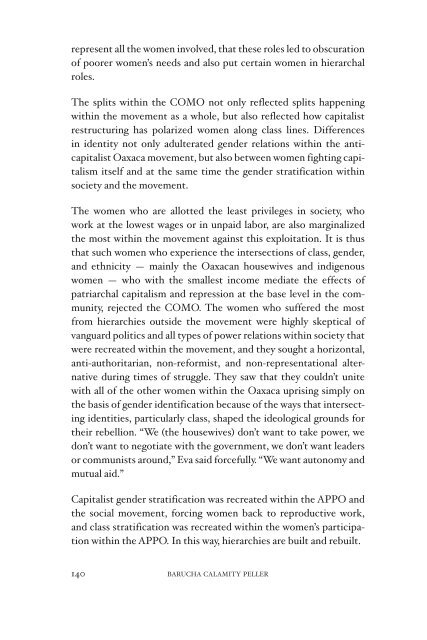Lies: A Journal of Materialist Feminism - Libcom
Lies: A Journal of Materialist Feminism - Libcom
Lies: A Journal of Materialist Feminism - Libcom
You also want an ePaper? Increase the reach of your titles
YUMPU automatically turns print PDFs into web optimized ePapers that Google loves.
epresent all the women involved, that these roles led to obscuration<br />
<strong>of</strong> poorer women’s needs and also put certain women in hierarchal<br />
roles.<br />
The splits within the COMO not only reflected splits happening<br />
within the movement as a whole, but also reflected how capitalist<br />
restructuring has polarized women along class lines. Differences<br />
in identity not only adulterated gender relations within the anticapitalist<br />
Oaxaca movement, but also between women fighting capitalism<br />
itself and at the same time the gender stratification within<br />
society and the movement.<br />
The women who are allotted the least privileges in society, who<br />
work at the lowest wages or in unpaid labor, are also marginalized<br />
the most within the movement against this exploitation. It is thus<br />
that such women who experience the intersections <strong>of</strong> class, gender,<br />
and ethnicity — mainly the Oaxacan housewives and indigenous<br />
women — who with the smallest income mediate the effects <strong>of</strong><br />
patriarchal capitalism and repression at the base level in the community,<br />
rejected the COMO. The women who suffered the most<br />
from hierarchies outside the movement were highly skeptical <strong>of</strong><br />
vanguard politics and all types <strong>of</strong> power relations within society that<br />
were recreated within the movement, and they sought a horizontal,<br />
anti-authoritarian, non-reformist, and non-representational alternative<br />
during times <strong>of</strong> struggle. They saw that they couldn’t unite<br />
with all <strong>of</strong> the other women within the Oaxaca uprising simply on<br />
the basis <strong>of</strong> gender identification because <strong>of</strong> the ways that intersecting<br />
identities, particularly class, shaped the ideological grounds for<br />
their rebellion. “We (the housewives) don’t want to take power, we<br />
don’t want to negotiate with the government, we don’t want leaders<br />
or communists around,” Eva said forcefully. “We want autonomy and<br />
mutual aid.”<br />
Capitalist gender stratification was recreated within the APPO and<br />
the social movement, forcing women back to reproductive work,<br />
and class stratification was recreated within the women’s participation<br />
within the APPO. In this way, hierarchies are built and rebuilt.<br />
140<br />
BARUCHA CALAMITY PELLER

















